Piltdown fossils
Explore the fossilised remains and artefacts that shot Piltdown Man to fame as the missing link between apes and humans, later revealed to be part of an elaborate hoax.
Skull fragments
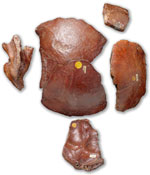
The 5 pieces of human skull found at Piltdown. The first was apparently handed to Charles Dawson in 1908 by a man who found it while digging gravel beside the road to Barkham Manor. The other pieces were found in 1911 and 1912.
The unusually thick fragments were said to be stained brown by iron in the gravel bed. In reality they were probably stained using iron sulphate to match the gravel.
We now know from radiocarbon dating that they are only about 1,000 years old. They are from a modern human.
Jaw and teeth
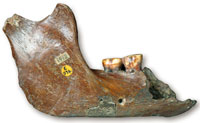
Found by Dawson on a late summer evening, the jawbone itself did not look particularly human but the teeth it held did. They appeared to have been worn down in a typically human manner and looked very like those belonging to the Heidelberg jaw found in 1907, thought to be 500,000 years old.
In 1953 it was revealed that the jaw and teeth probably belonged to a young orangutan and that the teeth had been carefully filed flat to give the appearance of human tooth wear.
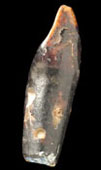
Canine tooth
The canine tooth was found by the priest Teilhard de Chardin in August 1913. It was worn and appeared to confirm the status of Piltdown Man as the missing link, matching Smith Woodward’s prediction that it would be intermediate in size between that of apes and humans.
It too was coloured brown, supposedly by the iron in the gravel bed. In 1955 the colour was revealed to be paint, probably the pigment known as Vandyke brown.
Skull reconstruction
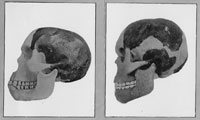
The fossil fragments were used to reconstruct their owner's skull by 2 key players in the Piltdown mystery, Arthur Smith Woodward from the Natural History Museum and Sir Arthur Keith from the Royal College of Surgeons. Their opinions differed, as shown in the image (Smith Woodward's reconstruction is on the left).
In 1953 it was revealed that, as well as being much younger than originally proposed, the skull and jaw fragments came from 2 different species.
The 'cricket bat'

A piece of fossil elephant thigh bone shaped by human hands. This unusual item was found at the dig site in 1914, supposedly thrown away by workmen. It was presented as a digging implement and commonly referred to as the Piltdown cricket bat.
Some theories suggest it was put there specifically to alert people to the hoax, but at the time it was thought to be genuine. We now know it was shaped with a steel knife.
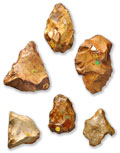
Stone tools and animal fossils
A variety of animal teeth and flint tools (shown in the image) were found in the gravel bed with the Piltdown Man fossils. In 1912 their existence was taken as evidence of Piltdown Man's diet and tool use and helped date the finds.
In 1953 radioactivity and fluorine tests revealed these did not come from Piltdown and must have been planted. The flints were all artificially stained. The presence of so many fossil mammal teeth and no other bones also raised suspicions.